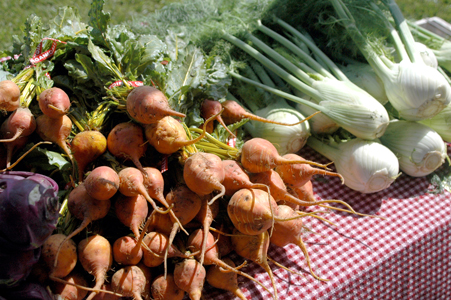
BALLE helps SBC define potential opportunities
A yearlong look at the local economy in San Benito County has
found some unique niches for future economic development.
BALLE helps SBC define potential opportunities
A yearlong look at the local economy in San Benito County has found some unique niches for future economic development.
The look at the economic development of the county started in April 2005 when the Central Coast Recycling Market Development Zone, which is made up of four counties, hired a consultant from the Business Alliance for Local Living Economies, a non-profit organization that works with communities to help with economy strategies.
The goal of the Central Coast RMDZ is to increase the use of recycled materials in manufacturing and reuse through low interest loans. They found that few businesses in San Benito, San Luis Obispo, Monterey and Santa Cruz counties were taking advantage of their programs.
“We decided to do workshops as another way of getting information out,” said Mandy Rose, the director of Integrated Waste Management and the current administrator for the Central Coast RMDZ. “We hired BALLE to do those workshops. They held a philosophy that was appropriate not only to meet the goals, but that would help our local economy.”
With the sewer moratorium within the city of Hollister and the growth cap of 1 percent in unincorporated San Benito County, growing the economy has constraints such as a limitation on putting up new buildings and drawing new residents to the region.
“There is a way to grow your business without more people,” Rose said.
BALLE set out to meet with local leaders and business owners in workshops that discussed the strengths and weaknesses, such as the sewer moratorium, of the overall county.
“The No. 1 thing that the city has to solve is the sewer moratorium,” said Jeff Pyle, the economic development manager for the city of Hollister. “There are other things that are important, but nothing is more important than that.”
Don Shaffer, the national coordinator of BALLE, identified five industries that are growing at a steady rate. He included production and sales of organic and locally produced food, agricultural tourism, revitalized downtown shopping districts, the production of “green” or environmentally friendly building materials, and alternative energy development.
“Americans, and especially Californians, are fueling growth in the following multi-billion dollar sectors of the economy,” Shaffer wrote in a report to Rose. “Fortunately, San Benito County and the cities of Hollister and San Juan Bautista are positioned well to take advantage of these trends.”
The initial report on phase one of Shaffer’s consultation included ways San Benito might be able to take advantage of the trends in some growing industries as well as the advantages to pursuing them.
Shaffer took into account some of the strengths of the county and features that lead to the quality of life, such as the abundance of agricultural spaces. Total agricultural revenue brings in $238 million in the county and 5 percent of those sales are from organic growers.
The organic food market has grown more than 20 percent in the past 10 years and with more than 30 registered organic growers in the county, Shaffer saw great potential for growth in the market.
Some of the strategies Shaffer recommended tie together. A “buy local” campaign in San Benito County could increase the sales of locally and organically grown produce.
“We are focusing on getting people to spend a little more of their shopping dollar in Hollister,” Pyle said. “We have a modest goal of 10-15 percent more shopping.”
A buy local campaign would focus on informing people about how spending locally benefits the local economy, Pyle said.
If the campaign is a success, Pyle envisions a marketplace space that would be open all year long. Currently, residents can purchase local produce and products at a summer farmer’s market once a week. The county has plenty of potential products for a permanent marketplace in locally grown wine, vegetables and fruits, as well as beef and chickens.
“I see the downtown as an important part of it,” Pyle said.
During the second phase of the project, which started in September 2005, Shaffer presented the initial economic strategy ideas to local business owners and community leaders to get their input on the project. Since then, several committees have been set up to continue strategizing and moving forward on projects within the industries identified.
“I thought a lot of the recommendations and the things [Shaffer] has been working on are right on the mark,” Pyle said.
The Hollister Downtown Association, the San Benito Winegrowers Association and the Tourism Committee of the Chamber of Commerce are working with BALLE to create a business plan for a wine bar and tapas restaurant in downtown Hollister. The venue would showcase local Hollister wines and locally grown fruits, vegetables and beef.
Local community members have also teamed up to research the potential of biofuel production in the region, the use of building materials and wood products and to look at agriculture issues.
“Taking a look at local solutions may be our best alternative,” Pyle said. “Continue to do the things we do best.”







